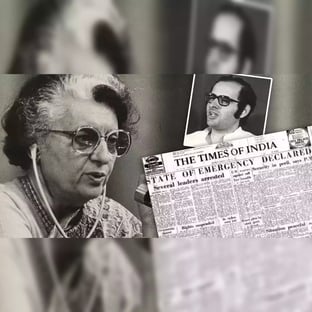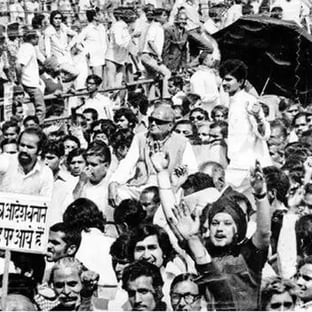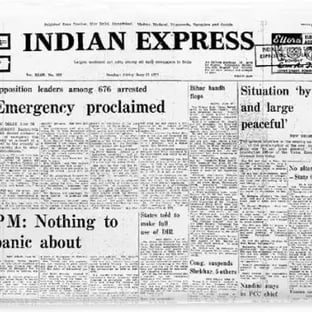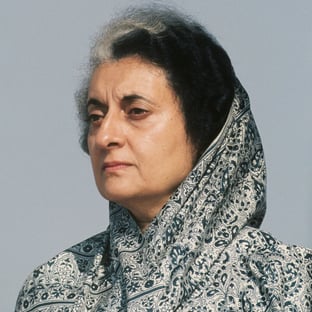The Emergency in India (1975–1977): The 21-Month Darkness of Democracy
Democracy suspended by Indira Gandhi – A dark period in Indian constitutional history.
GOAT NEWS
Hindvarta Desk
6/10/20253 min read
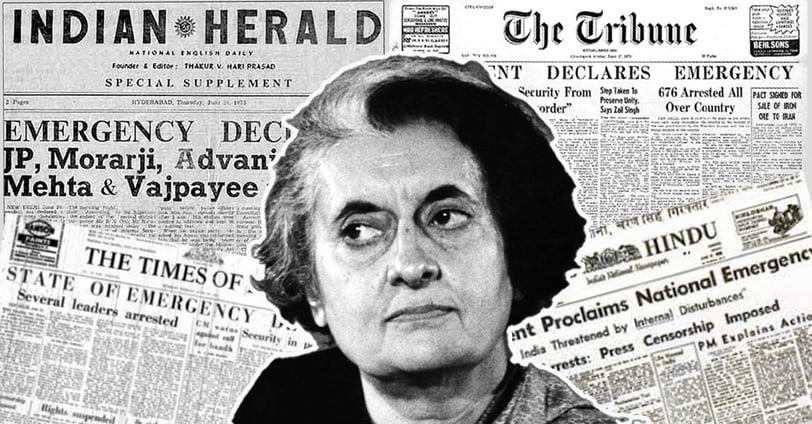

The proclamation of Emergency is nothing but a fraud on the Constitution.” – Jayaprakash Narayan
On the night of June 25, 1975, as the nation slept, Indian democracy was shaken to its core. Prime Minister Indira Gandhi, citing internal disturbances, imposed a nationwide Emergency, granting herself extraordinary powers and suspending civil liberties across the country.
The next 21 months (from June 25, 1975, to March 21, 1977) would be remembered as one of the darkest and most controversial chapters in Indian democratic history — a period marked by censorship, mass arrests, forced sterilizations, and a crackdown on dissent.
Why Was the Emergency Declared?
The Emergency was declared under Article 352 of the Indian Constitution, which allows the President to impose Emergency if the security of India is threatened by war, external aggression, or internal disturbances.
The official reason given was the threat of internal instability. But the real catalyst was political.
Earlier in June 1975, the Allahabad High Court found Prime Minister Indira Gandhi guilty of electoral malpractices during the 1971 Lok Sabha elections. The court declared her election void and barred her from holding elected office for six years.
Faced with massive public protests, led primarily by Jayaprakash Narayan (JP) and a coalition of opposition leaders calling for her resignation, Indira Gandhi opted to tighten her grip on power instead. On the advice of her loyalists and citing national security, she persuaded President Fakhruddin Ali Ahmed to declare a state of Emergency.
What Happened During the Emergency?
Suspension of Fundamental Rights
Citizens could no longer move the courts to challenge the government.
Article 19, guaranteeing freedoms such as speech, assembly, and press, was suspended.
Thousands of political activists, students, and journalists were arrested without trial under the Maintenance of Internal Security Act (MISA).
Censorship and Media Control
Press censorship became the norm.
Newspapers had to submit content to government censors before publication.
Prominent newspapers like The Indian Express and The Statesman resisted censorship but faced raids and intimidation.
One of the most chilling symbols of this time was a blank editorial space published by The Indian Express on June 28, 1975 — a silent protest against the silencing of voices.
Mass Arrests and Detentions
Over 100,000 people were arrested.
Key opposition leaders — Atal Bihari Vajpayee, L.K. Advani, George Fernandes, Morarji Desai, Jayaprakash Narayan, and others — were jailed.
Student movements, trade unions, and civil rights organizations were dismantled.
Forced Sterilizations
Perhaps the most infamous policy during the Emergency was the aggressive population control campaign led by Indira Gandhi’s son, Sanjay Gandhi. Under this program:
Millions of men, especially from poor and rural backgrounds, were forcibly sterilized.
In some states, access to basic amenities like ration cards and electricity was made conditional on sterilization.
The coercion, medical negligence, and lack of consent led to widespread fear, resentment, and human rights violations.
Slum Demolitions and Urban “Beautification”
In Delhi, large-scale slum demolitions were carried out in the name of urban renewal.
Thousands were evicted and relocated with little or no compensation.
These measures were widely criticized as being inhumane and arbitrary.
The Role of the Judiciary and Bureaucracy
The Emergency exposed how fragile democratic institutions can become under authoritarian pressure. The Supreme Court, in the infamous ADM Jabalpur v. Shivkant Shukla (1976) case, ruled that even the right to life could be suspended during the Emergency — a judgment that remains widely condemned today.
The bureaucracy largely complied with the Emergency regime, with many civil servants turning into enablers rather than protectors of democratic processes.
The 1977 General Elections: People’s Verdict
By early 1977, sensing public discontent and international criticism, Indira Gandhi unexpectedly called for general elections. Most believed that her Congress party would win comfortably. But the people spoke otherwise.
The Janata Party, a coalition of opposition leaders who had united while in jail, won a landslide victory.
Indira Gandhi herself lost her seat in Rae Bareli, and the Congress was reduced to just 153 seats in the Lok Sabha.
It was a triumph of democracy. The people of India had shown that they would not tolerate autocracy.
Aftermath and Reflections
The new Janata government, led by Morarji Desai, revoked the Emergency and released all political prisoners. They also amended the Constitution through the 44th Amendment, making it harder for any future government to misuse Emergency provisions.
Though Indira Gandhi returned to power in 1980, the scars of the Emergency never completely faded.
Why the Emergency Still Matters Today
The Emergency remains a stark reminder of how fragile democracy can be — and how quickly freedoms can be lost when power goes unchecked.
It teaches us:
The importance of a free press
The need for an independent judiciary
The role of civil society in preserving liberty
In today’s times, when democratic values are again under strain in many parts of the world, the lessons of 1975–77 feel more relevant than ever.
Conclusion
The Emergency was not just a political event. It was a constitutional, moral, and social crisis that tested the strength of Indian democracy. It revealed both the dangers of unchecked power and the resilience of the Indian people.
More than four decades later, it remains a somber chapter — but also a cautionary tale — in the evolving story of the world’s largest democracy.
